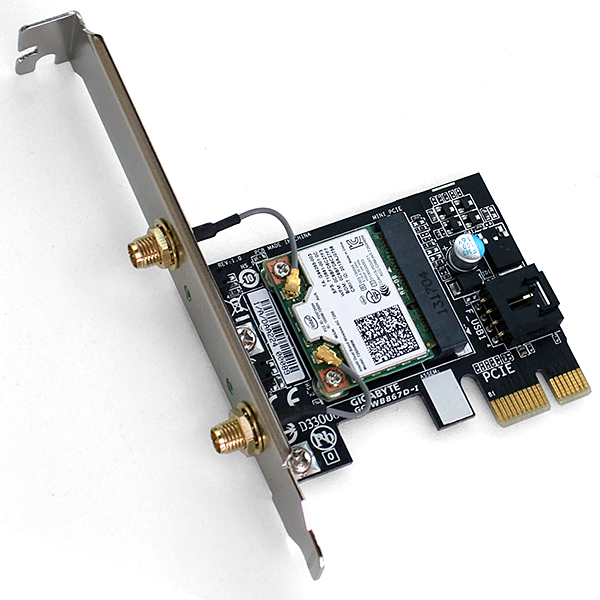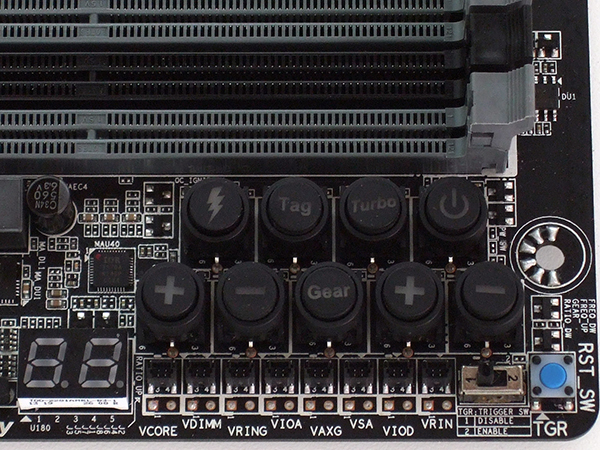Four Z87 Express Motherboards For Three- And Four-Way SLI
Formerly a very exclusive component, the PCI Express switch that makes Intel’s LGA 1150-based platforms three- and four-way SLI-capable is now available across a range of high-end motherboards. Today we compare four premium enthusiast-oriented models.
Gigabyte Z87X-UD7 TH
Why you can trust Tom's Hardware
Gigabyte attempts a features coup with its Z87X-UD7 TH, beginning with the Thunderbolt headers found on ASRock’s sample and continuing into the two-lane RAID controller supported by Asus. We also find the pair of USB 3.0 hubs used by ASRock, along with the two I/O panel and two front-panel ports those hubs supply.
Gigabyte ups its Wi-Fi ante with a $55 dual-band 802.11ac / Bluetooth module manufactured by Intel. Supporting 867 Mb/s transfer rates, the module rests upon a PCIe 2.0 x1 expansion card.
It turned out that the U.S. had a brief exclusive with the board at a lower-than-expected price. After its recent worldwide launch, pricing info looks a lot more realistic. Today, Newegg lists the Z87X-UD7 TH for sale at $430.
Further inspection proves that the Z87X-UD7 TH looks the part of a $430 motherboard. In addition to the expensive PCIe 3.0 switch needed to make three- and four-way SLI work, the motherboard-down RAID controller, the Thunderbolt controller needed to pipe data across the mini-DisplayPort connector, and the PCIe 2.0 switch needed to give Thunderbolt devices their connectivity without disabling other on-board devices, we also find a 16-phase voltage regulator. Oh, and about Thunderbolt: this is the first board from Gigabyte to be Thunderbolt 2-certified, combining both 10 Gb/s channels into a single 20 Gb/s channel.
Anyone who thinks they might be able to push the limits of that 16-phase voltage regulator also knows that they’re going to make a lot of heat. Gigabyte equips the Z87X-UD7 TH voltage regulator with both a fan and a liquid-cooling channel.
Buttons at the front of the board control both base clock and multiplier ratios through a background application, which is perfect for tuners who don't want to reboot or open up another GUI while making adjustements. Other buttons control base clock increment size (0.1 or 1 MHz), enable a pre-configured overclock setting, and save current settings with a tag after resetting BIOS. Yet another button sets the system to retain component power after shut down…which would be perfect if the firm would introduce a DDR3-based version of its i-RAM.
A few things are imperfect though, including a front-panel audio header that’s around 0.5” too far into the rear corner for the cables of some cases to reach, a second front-panel USB 3.0 header that’s sure to be blocked by a fourth graphics card, and the problem that the third graphics card covers up the last PCIe x1 slot. If you do use three or more double-slot graphics cards, you'll be forced to give up the valuable Intel 802.11ac/Bluetooth combo card.
If we were to give up the Wi-Fi card for the sake of three- and four-way SLI, the Z87X-UD7 TH would still look like a fairly solid sub-$400 board. It still includes two-, three-, and four-way SLI bridges, a CrossFire bridge, a 3.5” bay adapter for front-panel USB 3.0, and six SATA cables.
Get Tom's Hardware's best news and in-depth reviews, straight to your inbox.
-
iam2thecrowe Am i missing something here? I dont see the point of reviewing 3 and 4 way sli boards and not testing 3 and 4 way sli. Seems rather pointless since any average motherboard will perform well in adobe, productivity etc benches dependent on the cpu....Reply -
Crashman This was really just about finding any board that supports Nvidia's requirements about how that third card is connected. We found some, I overclocked them, now I have enough data to pick a board for the System Builder Marathon. But that only explains why overclocking took priority!Reply
After spending two days per board on a "one week" article, I couldn't add more tests. The general benchmark set looks for unintended overclocking/underclocking, power and memory bandwidth issues, so you can see the performance difference attributable to each board's CPU and DRAM configuration differences. It runs from a .bat file, so it didn't add significantly to the article's completion time.
The PLX bridge that these all share represents the "great equalizer" when it comes to CrossFire and SLI configuration, so that portion of all three boards should be identical. I understand that things that should be the same in theory are occasionally different in practice. My apologies for not having the extra 1-day per board for additional tests. -
iam2thecrowe Reply12341788 said:They all use the same PLX bridge, so you would have seen a whole bunch of identical gaming results. The general benchmark set looks for unintended overclocking/underlocking, power and memory bandwidth issues, so you can see the actual performance difference. And there's still an overclocking section.
These boards had to be tested for general performance and stability like any other boards. The PLX controller is the equalizer when it comes to games.
I think testing 3/4 way sli would still be valid, as it doesn't always work properly, in the past there have been compatibility problems with certain gpu's/boards/firmware/controllers and certain benchmarks completely failed. -
Kraszmyl "internally-mounted external USB 2.0 port for ReadyBoost fanatics" on the asus z87.Reply
Those have nothing to do with readyboost. The internal usb ports are very common on workstations and you put CAD dongles and equivalent items in them so that you can lock them inside the case and don't have to worry about some one stealing them from the outside or them taking up an outside usb port. -
Memnarchon I would love to see Asus Maximus VI Extreme, but it seems ASUS didn't want to give a 2nd board and prefered the Z87 WS....Reply -
Traciatim where are the sli/crossfire benchmarks and comparisons with traditional non-switched setups?Reply
Hey guys, we have these awesome new setups for supreme graphics pumping power! Watch it zip files like every other board! -
duramax08 Why are they still making motherboards with PS/2 connections? Its time to move on, replace those baby's with some USB 3.0!Reply






